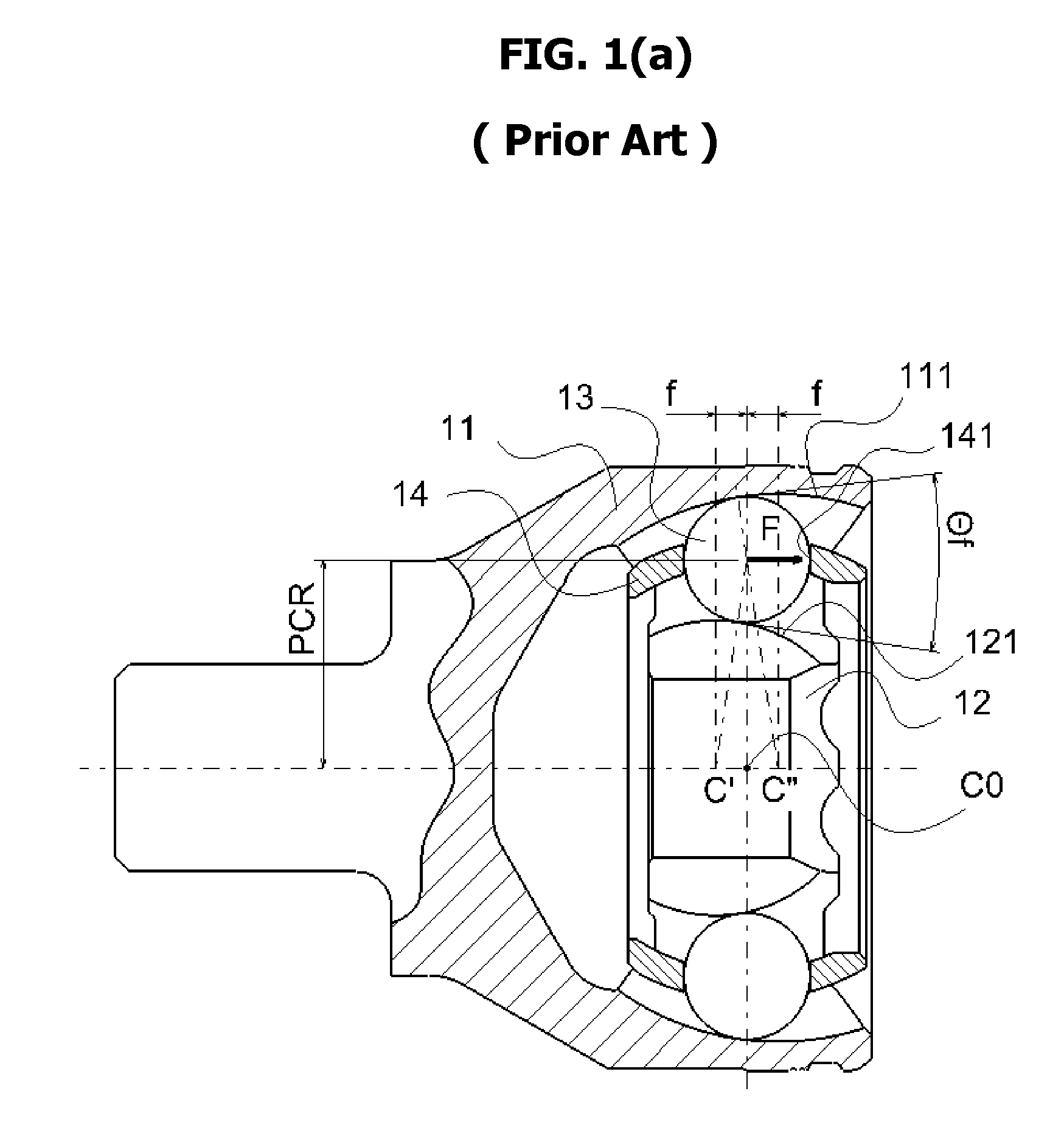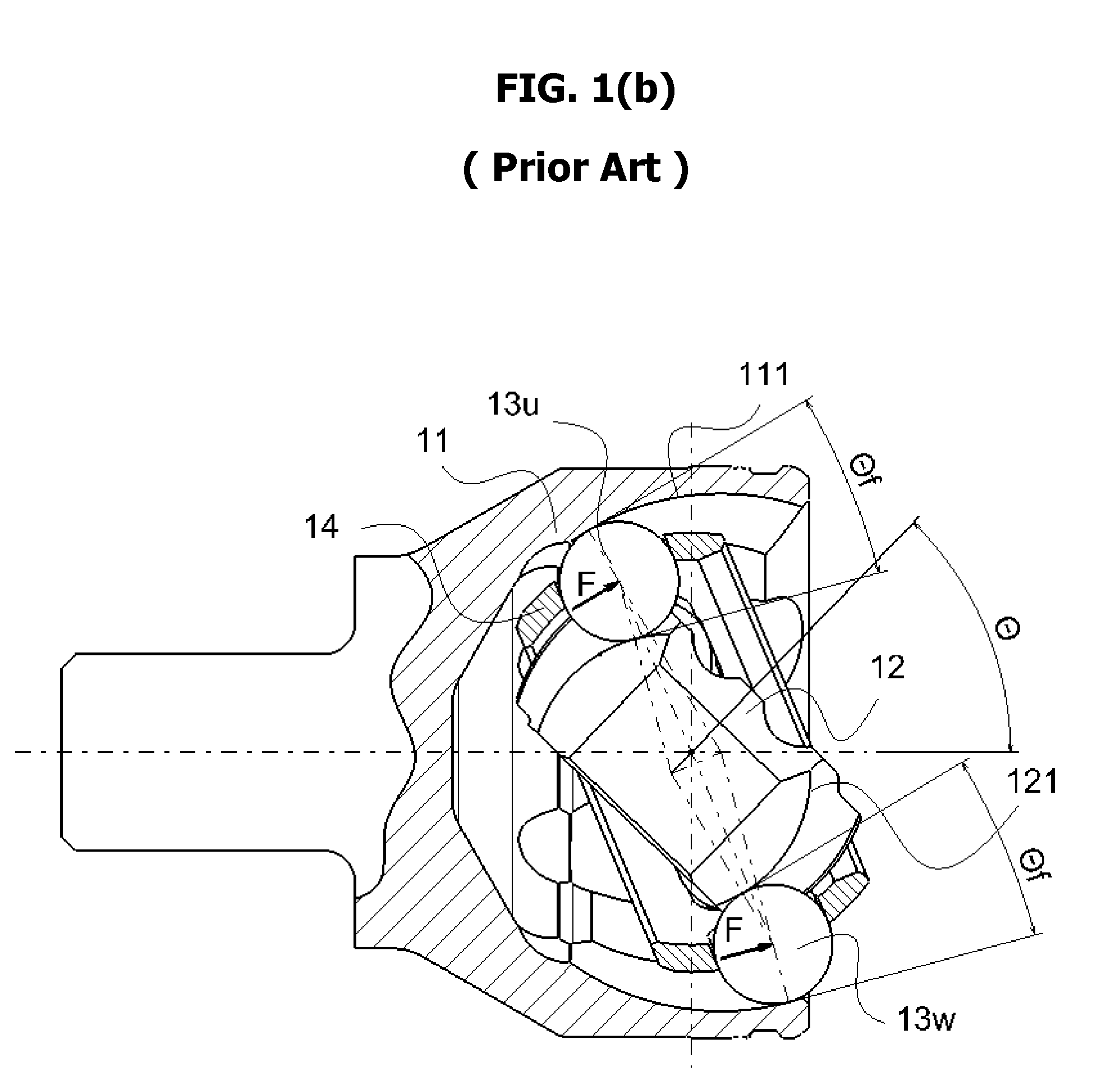Fixed type constant velocity joint
a constant velocity joint, fixed technology, applied in the direction of yielding couplings, rotary machine parts, couplings, etc., can solve the problems of reducing the strength and durability of cages, limiting the assembly angle of joints, and single circular groove shape of rzeppa joints, etc., to achieve suitable strength and durability, reliable construction
- Summary
- Abstract
- Description
- Claims
- Application Information
AI Technical Summary
Benefits of technology
Problems solved by technology
Method used
Image
Examples
embodiment 1
[0037]With reference to FIGS. 5(a)-5(c), the first embodiment of the invention is described herein. As illustrated in FIG. 5(a), a fixed type constant velocity joint of this embodiment includes a plurality of (namely, six, eight, or more) ball guiding tracks each defined by a pair of corresponding inner and outer ball grooves. The ball grooves define variable funnel angles therein, and the cross sectional shape of each groove is composed essentially of two circular regions with different centers (thus, in offsets) and an intermediate linear segment connecting tangentially between the two circles. As mention above, the funnel angle is defined as the angles between the tangential lines at the ball contact points in the outer ball grooves and inner ball grooves when the joint is in a specific joint operating angle.
[0038]As shown in FIG. 5(a), the ball groove of outer race 11 includes circular region C1 (i.e., a first circular region) disposed at a first lateral side S1 (or right side i...
embodiment 2
[0041]With reference to FIGS. 6(a)-6(d), the second embodiment of the invention is described herein, directed to another application of the variable funnel angle groove structure of the invention, one example of which described above in connection with the first embodiment. This embodiment includes common aspects with the first embodiment, however, having certain differences as described below.
[0042]While the groove shape shown in the first embodiment (i.e., FIG. 5) has the horizontally-formed groove region for linear portion (L1), the present embodiment as illustrated in FIG. 6(a) provides an inclined linear groove region. In this structure, the ball groove of outer race 11 includes circular region C1 (i.e., a first or right side circular region) with radius R1 and center T1, circular region C2 (i.e., a second or left side circular region) with radius R2 and center T2, and the linear region L1 connecting and extending tangentially between the two circular regions C1 and C2. Likewis...
embodiment 3
[0044]With reference to FIGS. 7(a)-7(d), the third embodiment of the invention is described herein, directed to another application of the variable funnel angle groove structure of the invention, examples of which described above in connection with the first and second embodiments. The present embodiment includes common aspects with the second embodiment, however, having certain differences as described below.
[0045]Similar to the groove shape of the second embodiment (i.e., FIG. 6), the present embodiment as illustrated in FIG. 7(a) provides an inclined or sloped linear groove region L1. However, in this embodiment, center T2 of circular groove C2 of outer race 11 and center T4 of circular groove C4 of inner race 12 are located in the opposite side of the joint center line L0. As illustrated in FIGS. 7(b) and 7(c), this application does not provide a substantial advantage for the improvement of strength and durability of outer race 11 and inner race 12, as well as, for the reduction...
PUM
 Login to View More
Login to View More Abstract
Description
Claims
Application Information
 Login to View More
Login to View More - R&D
- Intellectual Property
- Life Sciences
- Materials
- Tech Scout
- Unparalleled Data Quality
- Higher Quality Content
- 60% Fewer Hallucinations
Browse by: Latest US Patents, China's latest patents, Technical Efficacy Thesaurus, Application Domain, Technology Topic, Popular Technical Reports.
© 2025 PatSnap. All rights reserved.Legal|Privacy policy|Modern Slavery Act Transparency Statement|Sitemap|About US| Contact US: help@patsnap.com



